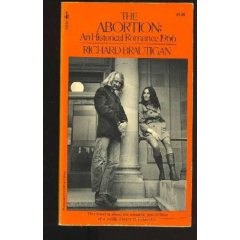Follow Author Richard Brautigan’s lead: Tell your own story.
And Michaele asks, “Did the famous Brautigan “Mayonnaise” Library make it to its new home at the Presidio branch library in San Francisco?…… Whether or not the collection actually made it, I have not been able to find out, despite many inquiries and phone calls to the Presidio Library.”
Telling Your Story
 Story by Michaele Benedict
Story by Michaele Benedict
In his novel The Abortion: An Historical Romance 1966,
Richard Brautigan wrote about a library where anyone with a story to tell could write it out and put it on the shelves for others to read. The overseer of the library, which was open 24 hours a day, lived there. The fictional library was based on the Presidio Branch of the San Francisco Public Library,
Inspired by Brautiganâs idea, in 1990, the Brautigan Library was founded in Burlington, Vermont, by Todd Lockwood, a Brautigan fan, together with poet Robert Creeley and Brautiganâs daughter Ianthe..
Instead of the Dewey Decimal System, used by most libraries, the Brautigan library categorized its books according to the Mayonnaise System, referring to the fact that the library in the novel used mayonnaise jars as bookends.
My unpublished novel, The Dioscuri, registered with the Brautigan Library on May 25, 1990, was given the Mayonnaise catalog number LOV1990.05.003. The 325 books of the Brautigan Library archive (which included Brautiganâs typewriter) traveled to Seattle for a book fair, then back to its basement home in Vermont. It changed addresses in Burlington a number of times, finally winding up in the public library.
In 2005 the Fletcher Free Library in Burlington decided it would be fitting to ship the collection to the Presidio branch of the San Francisco Public Library. Whether or not the collection actually made it, I have not been able to find out, despite many inquiries. The last posted information about the move was a 2005 story in the Boston Globe.
What I wanted to talk about, however, was not the Brautigan Library  itself but rather the idea behind a library where everyone could tell his or her story, without the assistance of agents, publishers and editors. True, there is the Internet. But not everyone has access to a computer, and some people still like the idea of something written on paper.
itself but rather the idea behind a library where everyone could tell his or her story, without the assistance of agents, publishers and editors. True, there is the Internet. But not everyone has access to a computer, and some people still like the idea of something written on paper.
I spend at least four hours a day writing at the computer, mostly for fun these days, though occassionally I will send something off to a magazine, and once in a while something will be published. I am a hundred pages into âMurder at the Parthenon,â? a mystery novel set at a Tennessee newspaper in 1954. Certainly this effort is spurred by the love of the old newspaper technology, with its Linotypes and locked pages. I meet regularly with a writer friend so we can toss ideas back and forth, and nag each other about keeping our noses to the grindstones.
I am working on a biography of the pianist and Teacher, Egon Petri, part of which has appeared in magazines and on a piano pedagogy website originating in Finland, of all places. I am editing a wonderful work in progress by a friend who wants to tell her story about meditation. And I am proof-reading an exquisite collection of songs by a composer friend.
There is a modern facility which somewhat resembles Richard Brautiganâs library. My nonfiction mystery, Searching for Anna,  was published in February by Lulu.com. Lulu is an international print-on-demand publisher, some of whose thousands of titles strongly evoke those of Brautiganâs fictional library, such as âGrowing House Plants By Candlelightâ?.
was published in February by Lulu.com. Lulu is an international print-on-demand publisher, some of whose thousands of titles strongly evoke those of Brautiganâs fictional library, such as âGrowing House Plants By Candlelightâ?.
Anybody can tell a story on Lulu. For a small fee, a book can even get an ISBN number and be entered into Books in Print, which means it is available through outlets such as Barnes and Noble and Amazon.
Everyone has a story. Jung said that in most disassociated ânormalâ? living, oneâs story was often interrupted. He said psychologyâs primary function was to retrieve that story and reunite the individual with it.
One of the best pieces of writing I ever encountered was by a Skyline College student who had brought his essay to the Tutoring Center, hoping for help with his English. The story, laboriously written in longhand, was about how to wash dishes. The studentâs grandmother had taught him the proper way to wash dishes, and in the telling of the story, the student revealed himself: Loving, respectful, obedient, attentive to detail, humble. The language was awkward, but the story was truly touching.
How to tell your story: Hemingway said to place the seat of the pants on the seat of the chair and move the hand from left to right, or something to that effect.
I would add a bit about spelling and grammar, but it really seems to be mostly about having
something to say, saying it as honestly as you can, and then hoping somebody reads it and understands what you meant.
———-
Author Michaele Benedict lives in Montara. To read Mikieâs âSearching for Annaâ? website click here
âSearching for Annaâ? tells the heartbreaking story of Michaeleâs search for her beautiful young daughter, snatched from her Purisima home in the early 1970s. For info and to purchase the book, please click here. Email Michaele: [email protected]


